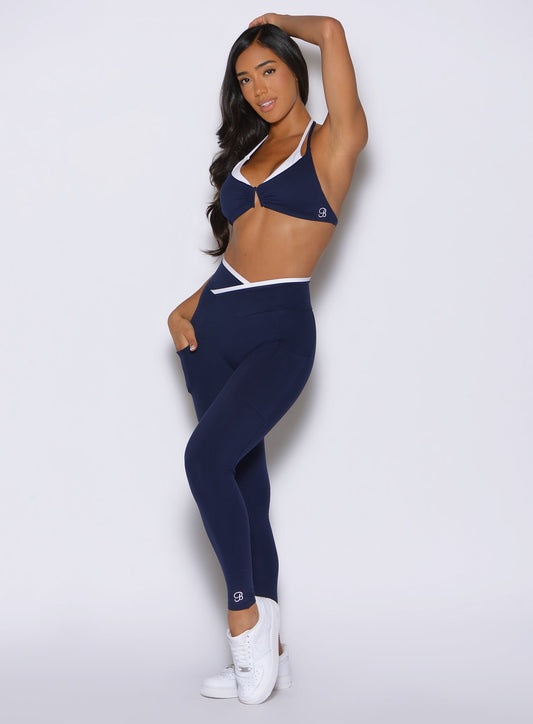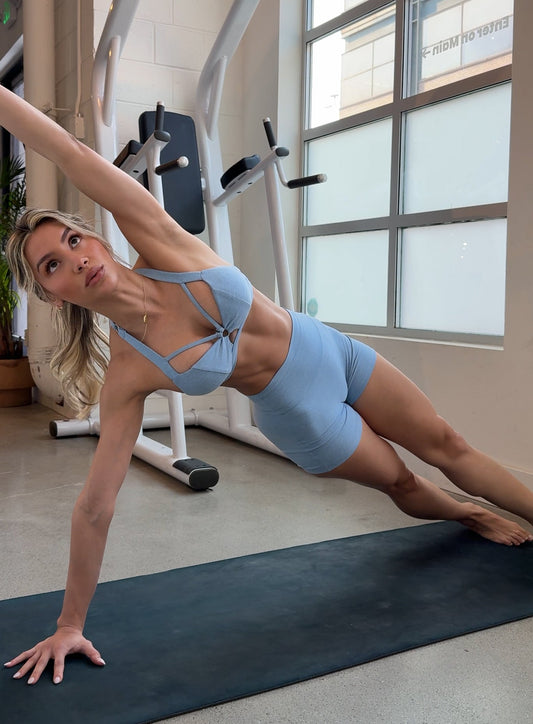Whether you're powering through a HIIT session or recovering from strength training, one thing remains constant: flexibility is the foundation of injury-free movement. From yoga flows to mobility drills, flexibility training supports muscle function, joint health, and performance longevity.
At Bombshell Sportswear, we’re all about strength—but we know it’s nothing without mobility. In this guide, we’ll answer common questions like “How can flexibility training reduce the risk of back pain?” and “How do you stretch a hip?”, while also recommending stretching clothes and flexible athletic wear for stretching exercises that support every movement
Why Flexibility Training Matters for Injury Prevention
When your muscles are flexible, they can move through a full range of motion with less tension and resistance. This doesn’t just make your workouts feel smoother—it protects your body from strain, misalignment, and overuse injuries.
Here’s why flexibility matters:
-
Better range of motion = smoother, safer movement
-
Looser muscles and joints = reduced risk of strains, sprains, and tendonitis
-
Improved alignment = better posture and less lower back pain
-
Fewer compensations = less stress on surrounding tissues
Still wondering how flexibility training can reduce the risk of back pain? Here’s the science: tight hamstrings and hip flexors can pull on the pelvis, leading to poor spinal alignment and discomfort. Regular hip and hamstring stretching relieves that tension, helping you stay pain-free through every squat and stride.
Static vs. Dynamic Stretching: What’s the Difference?
In summary, both types of stretching play a role in keeping your body injury-resistant:
Dynamic Stretching (Before a Workout)
-
Active, controlled movements
-
Boosts circulation and neuromuscular readiness
-
Prepares muscles for high-impact or strength work
Examples: walking lunges, leg swings, arm circles
Note: Do these before strength training, cardio, or high-impact workouts.
Static Stretching (After a Workout)
-
Stretch held in one position for 20–30 seconds
-
Helps muscles return to resting length
-
Reduces tension and promotes flexibility over time
Examples: seated hamstring stretch, hip flexor stretch, child’s pose
Note: Best for post-workout recovery, yoga flows, or rest days.
Scientific Insight: Does Flexibility Prevent Injury?
Studies show mixed results about stretching alone preventing injury. But one thing’s clear: tight, inflexible muscles are more likely to strain or tear under stress.
According to the American College of Sports Medicine (ACSM), flexibility training improves:
-
Muscle elasticity
-
Joint mobility
-
Movement efficiency
-
Risk reduction in high-stress sports and training
Bottom line? Stretching may not be a cure-all, but when paired with strength training and good movement patterns, it’s a key component of a safe and effective fitness routine.
Best Flexibility Exercises for Injury Prevention
To build a body that moves well and resists injury, try incorporating these into your weekly training:
Pre-Workout (Dynamic Stretching)
-
Leg swings
-
Bodyweight lunges with twist
-
Hip openers
-
Jumping jacks or air squats
Post-Workout (Static Stretching)
-
Seated forward fold (hamstrings & lower back)
-
Standing quad stretch
-
Chest opener against a wall
-
Supine figure-four stretch (hips & glutes)
-
Neck and upper trap stretch
Aim to stretch each major muscle group at least 2–3 times per week, and always warm up first. Want to know how to become flexible? Stretch consistently—at least 3 times a week. Progress happens over time, not overnight.
What to Wear for Maximum Mobility
Flexibility work demands clothing that moves with you—not against you. Bombshell Sportswear’s stretching clothes are designed to support every flow, twist, and hold.
Best Picks for Stretch Sessions:

-
V Butt Lift Leggings – Second-skin fit, seamless front, full range of motion

-
Toggle Sports Bra – Light to medium support for yoga and mobility.

-
Gym Crush Hoodie – Cozy for warm-ups, cool-downs, or recovery days
You don’t have to compromise style for functionality. Bombshell’s gear is built to stretch, bend, breathe—and turn heads.
What Happens If You Skip Flexibility Training?
Neglecting flexibility may lead to:
-
Tight hips and hamstrings
-
Imbalanced movement patterns
-
Poor posture and back pain
-
Higher risk of muscle strains during workouts
-
Reduced performance in strength and cardio sessions
Stretching takes 10 minutes—but skipping it can cost you weeks of downtime from preventable injuries.
Final Takeaway
Flexibility isn’t just about touching your toes—it’s your body’s insurance policy against injury and burnout. It helps you move better, train smarter, and recover faster.
If you’ve ever asked:
-
How can flexibility training reduce the risk of back pain?
-
How do you stretch a hip properly?
-
How to become flexible and stay injury-free?
…this is your answer: consistency + quality gear = mobility that lasts.
Move freely. Stretch confidently. Recover like a pro.
Shop Bombshell Sportswear’s Flexibility-Ready Fits
This article is for informational purposes only and not intended as medical advice. Always consult with a healthcare provider or fitness professional before beginning any new stretching or training program.
FAQs:
Does flexibility training really help prevent injuries?
Yes. Improved flexibility reduces muscle stiffness and increases range of motion, helping your body move more efficiently and decreasing the risk of strains, sprains, and overuse injuries.
What’s the difference between static and dynamic stretching?
-
Dynamic stretching involves active movements to warm up muscles before a workout.
-
Static stretching involves holding stretches after exercise to lengthen muscles and aid recovery.
-
Both support injury prevention in different ways.
How often should I do flexibility training?
Aim for at least 2–3 times per week. Consistency improves muscle elasticity, joint mobility, and performance over time.
Can I replace my workout with a stretching session?
Stretching is essential for recovery and mobility but doesn't replace cardio or strength work. However, flexibility sessions (like yoga or mobility flows) are excellent for active recovery days.
How can flexibility training reduce the risk of back pain?
Tight hips and hamstrings often contribute to lower back stress. Flexibility training helps release that tension, improving posture and reducing the likelihood of back pain.
How to become flexible if I’m just starting out?
Start with short, consistent sessions—3–5 times per week. Combine dynamic stretches before workouts and static stretches after, focusing on key muscle groups like hips, hamstrings, and shoulders.
How do you stretch a hip properly?
Use stretches like the hip flexor lunge, pigeon pose, or figure-four. Hold each for 20–30 seconds and avoid bouncing.
What should I wear for stretching or mobility work?
Choose stretching clothes that allow full movement and don't restrict your range of motion. Bombshell Sportswear’s Seamless Leggings, Low to Full Coverage Sports Bras, and Recovery Hoodies are ideal for comfort and flexibility.






















































































































































































